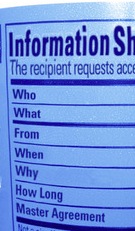In Taylor Swift, Spotify and the Musical Food Chain Myth, musician Doria Roberts (@DoriaRoberts) details a problem that we’ve been hearing about for the duration: artists have been getting screwed by the music industry, which now includes streaming services such as Spotify, paying tiny fractions of a penny for every tune everybody hears through them. She writes,
…not only have physical CD sales been down, but also the digital money I used to get from legal downloads all but disappeared. Instead of getting weekly payments ranging between $200-$750 from my distributor, I started getting an average $11.36, once a month from all streaming services combined. Yes, $11.36/month is what I get from all of them. That is not a sustainable business model for a truly independent artist.
And it will get worse as streams gradually become the main source for music. Signs and portents in that direction:
- Adele’s Manager: Streaming is the Future (Richard Smirke — @rsmirke — in Billboard)
- The Future of Media Will Be Streamed — For music and movies as things you buy and own, this is the beginning of the end (Derek Thompson in The Atlantic)
- Apple’s Slipping iTunes Sales Prove Streaming is the Future (Caitlin McGarry — @Caitlin_McGarry in MacWorld)
Doria also offers some answers:
HOW CONSUMERS CAN HELP REVERSE THE COURSE
As a consumer and a fan, you are at the top of this food chain, not the bottom. You are not subject to the whims of popular culture; you are the arbiter of it. If you want to see less “fluff” in the music industry, if you want to see your artists remain authentic, creative and prolific beings and, if you want them to come back to your hometowns:
1. Start buying our music again. Digital, hard copy, doesn’t matter, just pay for it. If you can pay $4 for a coffee, you can pay $9.99 for something meaningful that you’ll enjoy forever.
2. Stop using streaming services that only pay us $.0006 per listen if you don’t already own our music either via a legal download or a hard copy. Educate yourself. If you think the profits that oil companies make are obscene, I urge you to do some digging about what some of these streaming companies are really about. [Editor’s note: Spotify claims to have paid Taylor Swift over $2 million dollars in streaming royalties. Her label says that’s not even close to the truth.]
3. And, this is important: Set your DVRs on your favorite show nights and go to our concerts. If I had a dime for every time a person told me they weren’t able to make my show because it was the finals of DWTS or The Voice, I wouldn’t be writing this post. I’d be sitting in a bungalow in Costa Rica sipping something fruity and delicious.
Simple solutions sometimes require difficult choices. Oh, and this goes for independent movies, books, indie/feminist bookstores, small venues and small businesses, too. Just know this: you have the power to change the cultural landscape around you. Use that power wisely.
In reply below, I wrote,
All the course-reversing suggestions are good, but also assume that the only possible choices are the ones we have now. This has never been the case. We can invent new choices — new solutions for this already-old problem.
I believe the best solutions are those that make it very easy for consumers to pay whatever they want for whatever they like (and not just music).
One outline for this is EmanciPay, at ProjectVRM: . My own idea for an expression of EmanciPay is a user-side system set up to automatically pay (or pledge to pay) a penny per listen to any song heard anywhere, including one’s own music collection. That’s a high multiple of whatever coercive rates are being extracted on the supply side of the marketplace today — and in the whole future, which will suck.
Way back in ’98, when the DMCA birthed the ancestor of today streamed music royalty regime, it framed coercive rates with this context: “in the absence of a willing buyer and a willing seller.”
So let’s quit working only the seller-side of the marketplace. Let’s equip the willing buyer.
If anybody wants to work on the code for that, contact me (I’m not hard to find). We’ll get a posse together and go do it. Given the sum of existing code in the world already, it shouldn’t be too hard.
If we really are at the top of the food chain, we need better ways to pay for what we eat. If we don’t come up with those, all we will have are government-regulated ways to screw both the artists and the media. (Ask Spotify and Pandora how much they’re profiting in the current system.)
What we have today with streaming is guided by language like this (from the last link above):
…rates for the statutory licenses for webcasting and for ephemeral recordings must be the rates that most clearly represent the rates that would have been negotiated in the marketplace between a willing buyer and a willing seller. — http://www.copyright.gov/carp/webcasting_rates_final.html
The boldface is mine. Here’s my point: Regulators and their captors in the record industry have believed from the start that listeners to streams cannot be willing buyers.
I want to prove them wrong.
The time wasn’t right when we started writing about this back in the late ’00s. But now it is. Let’s do something about it.



 The idea is to start getting real about what we’re all doing and not doing.
The idea is to start getting real about what we’re all doing and not doing.
 For as long as we’ve had economies, demand and supply have been attracted to each other like a pair of magnets. Ideally, they should match up evenly and produce good outcomes. But sometimes one side comes to dominate the other, with bad effects along with good ones. Such has been the case on the Web ever since it went commercial with the invention of the cookie in 1995, resulting in a
For as long as we’ve had economies, demand and supply have been attracted to each other like a pair of magnets. Ideally, they should match up evenly and produce good outcomes. But sometimes one side comes to dominate the other, with bad effects along with good ones. Such has been the case on the Web ever since it went commercial with the invention of the cookie in 1995, resulting in a 
